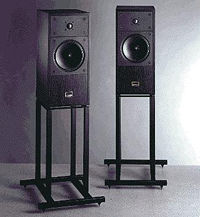Farad Azima founded Mission Electronics in 1977, and the 770 loudspeaker, the first to use a polypropylene mid/bass driver, appeared in 1978. It received a lot of positive feedback and projected a picture of a bold, forward-thinking, modern corporation in a historically conservative industry area steeped in history. Henry Farad, Farad’s brother, was a skilled engineer who created a slew of excellent innovations, including the Mission 774, the first DC-coupled transcribing tonearm, and the Mission 700 loudspeaker with its unusual, inverted driver unit array. The Mission 776, the world’s first DC-powered preamplifier, and the 777, the fastest MOSFET power amplifier at the time, were released in 1981. In 1985, the Cyrus amplifier line debuted, garnering critical acclaim as well.
The accolades kept pouring; in the early 1990s, Mission released the 760, which was a huge step up from the budget loudspeakers of the time. It appears blocky and rural now, but it was the pinnacle of budget speaker sophistication in May 1990. The injection-molded mineral-loaded polypropylene baffle, which was secured into a 15mm thick high density particleboard cabinet, was the important element; the objective was for it to be light and stuff, rather than storing energy. No one else had done such a design before, and the 760 appeared to be the form of things to come.
The 700 was Mission’s first affordable speaker, and it featured an inverted bass/mid/tweeter combination. The goal was to make the two drivers evenly spaced from the listener’s ear without the use of a complicated stepped baffle. The bottom 19mm treble unit was a Ferrofluid-cooled polyamide dome, while the higher 130mm driver was a doped paper cone. It was very efficient for a small (180x295x200mm) speaker of only 6.5 liters, with 89dB/1w/1m (stated sensitivity); likely the choice of paper for the mid/bass cone, rather than the heavier plastic drivers used by many competitors, and the front mounted reflex-port assisted here.
On a cold evening, the £119.95 760 sold like hotcakes, but Mission, being the firm it was, worked hard to keep it at the top of the sales lists. In 1991, the 760i received a number of updates, including a bigger magnet on the mid/bass unit and minor crossover modifications. Better polyester film capacitors, sturdier internal wiring, and a biwirable crossover configuration were added to the £149.95 760iSE in 1992. All models featured a nominal impedance of 6 ohms and a frequency response of 70Hz-20kHz 2.5dB.
The 760’s sound was a revelation; it was the first inexpensive standmounter I’d heard that was smooth and lovely. It seemed to mix the positives of the original KEF Codas from the early 1980s (warmth, effortlessness) with a tighter, tauter sound that seemed tremendously current at the time. In other words, it sounded more costly than it was, yet not in a dull way. Despite its diminutive size, it appeared to have a great heart and imaged far better than the 1980s speakers it was beginning to supplant. It made a lot of friends because of its capacity to produce a “out of the box” sound.
It was only at very high volumes that you could hear it compressing the sound, and it did it tastefully. The midband was also a tad opaque in absolute terms, but the 760’s cleverness was in the way it masked its traces. It was always evident that it wasn’t the best little speaker ever produced, but why wasn’t it obvious? The adjustments improved things, giving the 760i a tighter bass and more mid-range clarity, while the 760iSE sounded bigger, smoother, and more open – especially when birwired.
The best part about this speaker is that it is now on sale for only a few cents. A nice packed pair of 760iSEs should set you back £50, whereas the original 760s can be had for under £10. When it was new, it was a good budget buy, but now that it’s over a quarter-century old, it’s aged gracefully and is a fantastic deal.







